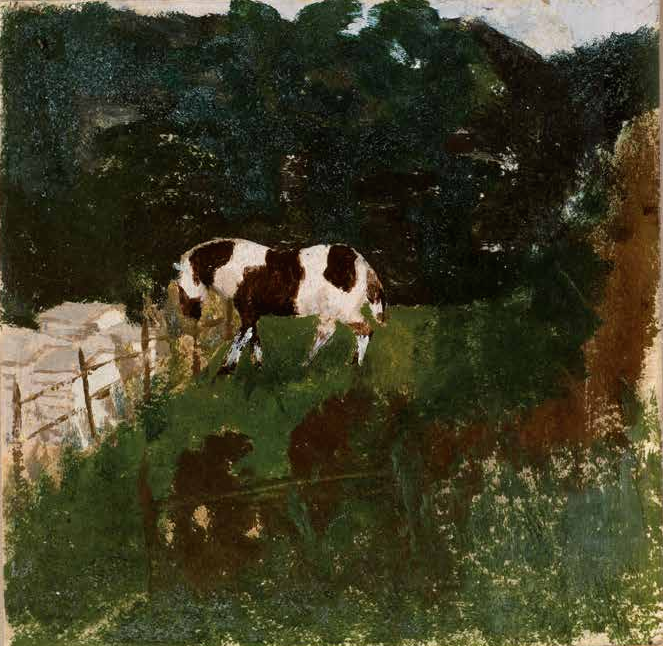|
|
Stanley Spencer 1891-1959 Piebald Pony and Beehives, Cookham c.1910-12 Oil on card 6 x 5 inches (15.2 x 12.7 cm) PROVENANCE Given by the Artist to Richard Carline; Private Collection. EXHIBITED Hampstead Artists, Hampstead Town Hall, London 1960; Sir Stanley Spencer C.B.E., R.A., 1891-1959, City Art Gallery, Plymouth 1963 (1); Spencers and Carlines in Hampstead in the 1920s, The Odney Club, Cookham, 1973. LITERATURE Keith Bell, Stanley Spencer: A Complete Catalogue of the Paintings, Oxford 1992 no.5. This is one of Spencer’s earliest paintings in oils, a medium that he taught himself how to use. Spencer evolved a sense of immediacy and transcendent intensity in these early paintings. They invariably represented his home village of Cookham – from which he commuted to the Slade every day – and the feelings of connection that it evoked in him. Later he was to describe it as ‘A Heaven on Earth’. The piebald pony grazed in a field adjacent to a spot featured in another early painting by Spencer, Two Girls and a Beehive (c.1910) which, he wrote, depicted ‘more or less the fields on the right at the bottom of Mill Lane’ in Cookham. Spencer’s intense, visionary connection to Cookham did not however make him isolated from avant-garde developments in the London art world. Spencer attended the lectures given by Roger Fry at the Slade from 1909, and it is almost certain that he saw the exhibition of modern French painting Manet and the Post-Impressionists that Fry staged at the Grafton Gallery in November 1910. Indeed for his second exhibition of advanced art, staged two years later, Fry selected Spencer’s John Donne arriving in Heaven to exhibit. In The Piebald Pony Spencer places the paint with a slightly fuzzy-edged touch that is somewhat reminiscent of works by Cézanne that Fry included in 1910 such as The Viaduct at L’Estaque (c.1883) or, perhaps more strongly, the pictures of Maurice Dennis (1870-1943), such as Ulysses and Calypso (1905). Spencer’s attention to Dennis, not least the other artist’s own transcendent subject-matter, was noted by Tonks in connection with his picture in the second Post-Impressionist exhibition, albeit a comment Spencer greeted with outrage as he always saw his own work as wholly original. Spencer merged this plethora of influences into a distinctive, individual style, and in a letter to the Spencer family his tutor Henry Tonks wrote: ‘In some ways he has shown signs of having the most original mind of anyone we have had at the Slade and he combines this with great powers of draughtsmanship’ (quoted in Maurice Collins, Stanley Spencer: A Biography, London 1962, p.39). |
|
Proudly powered by Weebly

